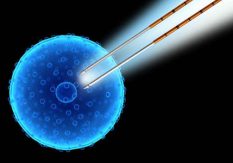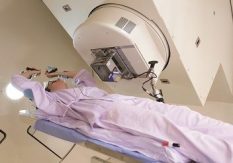


Every one of three people nowadays suffers from cancer during their lifetime. Along with the decline of the cardiovascular diseases rate and the increase of human being’s life expectancy by more than one month per year, the prevalence rate of cancer is increasing. In the foreseeable future, cancer will become the main cause of death, instead of cardiovascular disease. According to a statistics in Germany (see Figure), 450,000 people are diagnosed with cancer every year.
Around half of the malignant tumours are surgically removed. And about 40% (50% in the USA) are treated with radiotherapy, among which 27% are treated with radiotherapy only and 13% are treated together with chemotherapy. Radiotherapies or surgeries are regarded as local procedures, while chemotherapy and immunotherapy are systemic procedures which take effect on the entire body. Chemotherapy and immunotherapy are applied for only about 10% of all cancer patients as a sole treatment method.

Systemic therapy means to introduce a drug (in the case of cancer, a chemotherapeutic agent) into the bloodstream, which allows the introduced drug to act on the entire organism. The chemotherapeutic agent must be able to distinguish between healthy cells and cancer cells.
Rapid cell division often characterizes cancer cells, similar to healthy cells at hair follicles, digestive tract, and the bone marrow. Although a course of chemotherapy may destroy up to 99.9% of the cancer cells, it is almost inevitable that severe side effects will befall these healthy cells. Moreover, cancer cells may very quickly become resistant to the chemotherapeutic agent by mutating, or, in other words, undergoing a change in genetic material.
Systemic therapy is used on diffuse tumors such as leukemia (blood cancer). It is also used on other undiagnosed metastases and those cannot be localized due to their microscopic size. Chemotherapy is also suitable for solid tumors that cannot be treated via surgery or radiation.

Nano knife means to generate a extremely high ultrashort pulsed electric field (PEF) by electrode probe and form irreversible micro perforation on cancer cell membrane to induce the apoptosis of cancer cells. For patients with prostate cancer in the terminal stage, cells in IRE zone (inner zone) will be induced to apoptosis. At the same time, ECT treatments are used for the RE zone (outer zone). The permeability of cell walls increases with the effect of bleomycin injection, which allows cancer cells to increase their ability to absorb the chemotherapy drugs and accelerate the death of cancer cells.
Features of Nano knife
Painless, safe, accurate and fast are the key features of the application of Nano knife. Only those cells with membranes, for example cancer cells, will be destroyed during the ablation process by using Nano knife and other key tissues will be retained. It therefore leads to no sequela. The Nano knife treatment takes 2 – 3 hours and cancerous tissues are treated in one operation.
Radiation and thermal ablation form an ablation zone with a diameter of a few centimetres. Nano knife can clearly differentiate ablation zone and safe zone. The whole duration of operation is under constant monitor to avoid destroying healthy tissues. The Nano knife treatment does not cause any scar and coagulation necrosis of tissues. It therefore has no limitation on the subsequent treatment. When necessary, radiation and chemotherapy can be applied to assist the treatment.
In comparison to other ablation treatment, the Nano knife removes tumours in the “high-risk” areas while retaining healthy tissues. It is especially suitable for tumours that locate at “special areas”, such as prostate cancer, pancreas cancer and other tumours that locate at the places with key nerves and blood vessels (e.g. Hepatic hilar region, renal portal area etc.).

“Solid” tumors that have not metastasized significantly respond well to local treatment. Such tumors can either be removed surgically or destroyed using radiation. These local procedures may also be combined with chemotherapy. This approach is particularly effective for eliminating microscopic metastases in addition to the solid tumor.
Radiotherapy involves treatment with ionizing radiation. This includes any form of electromagnetic radiation and treatment with decaying radioactive substances. There are two types of radiotherapy: brachytherapy (short-range therapy) and teletherapy (treatment through the skin). Accelerated particles with sufficient energy to shift the electrical charge in the atoms of the cell (which “ionizes” the cell) are also used. All radiotherapy-based cancer treatments fall into this category.
Although ionizing radiation is not tumor-specific, it basically equally attacks tissues throughout. The non-specific action of radiotherapy, however, is a major advantage. It doesn’t give the cancer cells an opportunity to mutate and develop resistance. The genetic material of the cell is irreversibly destroyed in all the cells which are irradiated; thus, this treatment can only be used locally and selectively. Efficacy increases with more accurate targeting, as does the patient’s ability to tolerate the treatment well. Patients benefit from precise targeting of the tumor, because fewer healthy cells are destroyed. The more accurate the targeting, the better it is for the patient.

Both X-ray beams and proton beams can target location with extreme accuracy. However, the range of a proton beam can be precisely controlled, unlike an X-ray beam. This is due to a fundamental difference between the physical properties of the electromagnetic waves (x-rays) and those of the accelerated particles (protons).
Properties of proton beams
By the aid of cyclotrons or synchrotrons at 60% of the speed of light, protons penetrate into the body for approximately 38 cm. Protons firstly transfer relatively less energy to the molecular electron clouds which they pass through (low degree of ionization) and then slow down.
Using proton beams instead of X-rays allows the increase of the therapeutic dose, limited due to side effects, while simultaneously reducing the dose deposited in healthy tissue. In clinical practice, thanks to lateral bundling, this three-dimensional proton beam control, instead of two-dimensional, has reduced the radiation deposited in healthy tissue by 43% to 78%, depending on the tumour geometry.
Clinical benifits of proton therapy
Improves the probability of a cure – The target bundle of the proton energy in the tumour reduces the total radiation delivered to healthy tissue to only one-third or less, depending on the tumour geometry, in comparison to X-ray radiation with the same tumour dose. This enables a higher therapeutic dose to be used so that the tumour cells can be reliably destroyed. Theoretically, this means the probability of a cure rises in non-metastasized tumours.
Less severe side effects – The favourable ratio of useful radiation to damaging radiation in proton therapy allows the increase of the therapeutic dose, limited due to side effects, while simultaneously reducing the dose deposited in healthy tissue. Proton radiation is relatively well tolerated so that it can be implemented on an outpatient basis. This also substantially reduces the risk of a secondary tumour later on.
More treatment options – The radiation-free zone behind the tumour means proton radiation can be used on cancer forms where conventional radiation is too risky, such as tumours near the spinal cord or brain stem, bronchial carcinoma (lung cancer), or multiple metastases. For example, it is possible to target the retina without damaging the optic nerve or the portion of the brain behind the eye.
Reduced treatment time – Because proton therapy allows higher dose at each treatment, the numbers of necessary treatments can often be meaningfully reduced. This lightens the load of relevant personnel and facilitates shorter treatment time for patients.